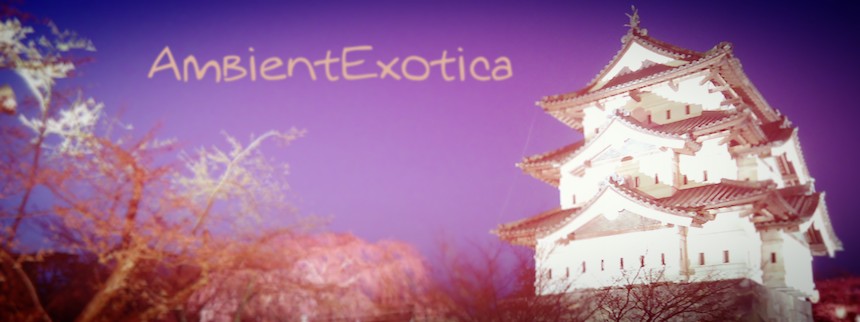
Ayota
Sōnen EP
2011
British electronic musician Dominic Oakenfull's two most important music projects materialize under the names of Ski Oakenfull, reserved for House and club tunes, and Ayota, which blends gentler beats with gorgeous synthscapes and Ambient textures – naturally, Ayota is the more interesting project for me that caught my eye for the first time back in 2007 when the Illuminations EP by Ski Oakenfull featured an Ayota Mix of the Deep House track. Even though I already liked the original Ski Oakenfull version very much, the Ayota Remix added subtle and barely noticeable alterations such as slightly different piano notes and softer beats and percussion – apart from these changes, both mixes sound pretty much alike. The trademark peculiarity of Ayota derives from Oakenfull's love for Japanese sound structures and the country's history and culture, both things I coincidentally love as well as you may see by means of my selection of Ambient reviews. This distinctly dreamy and modern Far Eastern flavor is skillfully mixed with electronic beats and synth layers which never get kitschy or clichéd.
After the Illuminations EP, Oakenfull released his first Ayota Album, Helicopter Cuts, also in 2007, available in Japan only but recently scheduled for a European release in the warmer months of the year. Luckily, the album will finally be released in the Western parts of the world in April 2012. Keeping this in mind, Ayota's Sōnen EP of 2011 is the latest release and consists of 5 beautiful tracks that oscillate between beatless Ambient tunes and deeply dreamy songs with added beats. Each song is a winner, and although not all of them are pitch-perfect examples of the genre, they are always mesmerizing, soothing and tremendously relaxing – and they even harmonize greatly in workout playlists!
Hashya Melodies starts with various Japanese voice samples and music box melodies before the typical Ayota backing chords are played in accompaniment of quickly-paced two-note melodies, whirling phone noises, dubby bass lines and the beautiful voice of Chihiro Butterfly. Of course I don't understand anything what she is singing about, but the Japanese language is somehow able to amplify the scintillating dreaminess of both her voice and the overall mood of the song. Although clave-like percussion and electronic xylophones appear soon after the introduction of the song, there is no perceptible drop of a beat, making this a proper but lively Ambient tune with a gorgeous interlude of beautiful synth washes and strings. Sōnen is the title-giving, pumping House track with distinct synth pads and fantastically oscillating layers. It is taken from Ayota‘s retrospective collection Selected Ambient Works 91–98 and re-edited on this EP. While this is no Ambient track at all, the mood is definitely positive and displays an overwhelming feeling of contentment. The synth strings which appear occasionally are of pristine quality and seem to glow. A towering track that unites the strength of Ambient synths with the energetic power of steady beats.
All Gone (Live) is a real Ambient track taken from a live performance for the Flomotion radio show in the U.K. and starts with mellow guitar pluckings, icily bright piano notes and spiraling synth pads. An electric guitar – or a resembling synth – adds an element of roughness to the tune. The blurry, glacial synths strings are the fragile counterpart. Centrair is another Flomotion live performance of an Ambient track with mystical but tense sawtooth strings, warped field recordings of birds, ethereal melody fragments and pristine piano notes that add a flavor of loneliness to an otherwise bustling track. The rumbling bass line brings a contrastive deepness to the sparkling, high-pitched ingredients. Centrair is an Ambient song that is evolving and pulsating permanently and begs for your attention. The final Aichi Expo is the second song with a steady beat and also a perfect, very strong sibling to Sōnen: clicks, crackles, pulses and the quavering voice fragments evoke the aura of a Microhouse track, but after approximately 90 seconds, the first glimpse of the main melody is audible while spacey vibraphone-like synth notes appear. Chihiro Butterfly sings in unison with the crystalline glints of synth pads and awe-inspiring background swirls. The track thus morphs from a minimal, reduced setup into a coruscating, warm and overjoyed fanfare without any cliché. Another very strong track with a distinctively Japanese style.
I conclude this review with a purposefully audacious question: why should you listen to Japanese music by a British producer if you have various Japanese artists who serve any niche of electronic music themselves? Well, because Oakenfull is tremendously successful with his approach. Even though this is the Ambient review section, I have to admit that his music transports the same spirits that make faux-Polynesian Exotica music so utterly great – it's the unspoken anticipation and the non-perceptible feeling of each listener that gets triggered by music like this. And that‘s exactly Oakenfull‘s goal, as Sōnen means »belief through imagination« – even without the bold Japanese lyrics and the front artwork, Ayota's music would deliver a perfect adaptation of a supposedly Eastern style due to its particular tone sequences. However, most connections are still drawn in the listener's head. This is a great EP and a fitting foil to the Helicopter Cuts album which contains similarly hypnotizing songs. A fantastic and curious EP, because it's the dance-driven songs that work best for me and which are effective additions to workout playlists as well as relaxation mixes. Highly recommended and extremely deep without being overly heavy or abyssal, as is the case with lots of Tech House tracks that build a similar atmosphere but with the help of excessive darkness and cracking beats. Ayota‘s approach is much more harmonious, and you should definitely check it out.
Further reading:
Dominic Oakenfull's Twitter account is @skioakenfull.
Ambient Review 033: Ayota – Sonen EP. Originally published on Feb. 8, 2012 at AmbientExotica.com.
